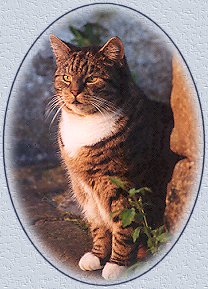Cats' Adventures & Travels 14
Oscar,
the 'Bionic' Cat
from Jersey,
Channel Islands
|
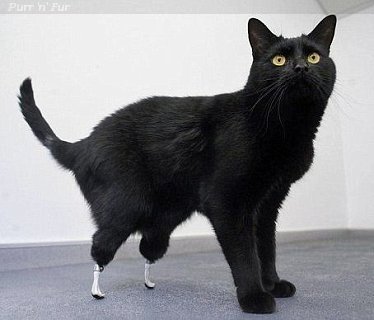
|
Left-click thumbnails for enlargements (JavaScript should be enabled),
but please allow all images to load before doing so, or some may not display
(if this happens, use Refresh from your toolbar to reload the page)
In 2007 Oscar went as a kitten with his sister Poppy, both black, to live with Mike Nolan and his partner Kate Allan after they had moved in together on Jersey, largest of the Channel Islands. There were two other cats of Kate's in the household, British shorthairs called Buzz and Lou; all four cats were much loved, but Oscar seemed to have a specially warm and loving personality and everyone who met him liked him.
Trouble with cars
He also seemed to be seriously accident-prone! Although the road outside the house wasn't particularly busy, and there's a 40 mph speed limit (64 km/h) on Jersey, it wasn't all that long before Oscar was hit by a car. He made it home and at first it didn't seem too serious; but in fact there was damage to his urinary tract and his tail, and quite complex surgery was needed, together with a skin graft. The total cost was several thousand pounds.
After a fairly lengthy recovery period, it wasn't long after he was more or less back to normal that he was again hit by a car. That time he dislocated his hip — but it wasn't just a matter of popping it back into place; it was an awkward dislocation and needed further expensive surgery. Oscar was not yet two years old. But 'the big one' was still to come.
Big problems
In October 2009 Oscar was sunning himself in a field not far from his home when he must have been caught in the blades of a combine harvester. Both his back feet were severed, and when he was found about an hour later by a lady who happened to be passing, he had lost a lot of blood and was close to dying. She alerted his owners and he was rushed to the vet's, who by now had got to know him quite well.
 The local Jersey vet, Peter Haworth, gave him emergency first aid and bound up the wounds, which subsequently began to heal quite well. The unsolved mystery was how the accident could have happened. Why had Oscar not taken flight, away from danger? Howarth offered a guess that he had been asleep and awoke disorientated by the noise of the approaching harvester's engine, which would be some way behind the cutting blades at the front. In a state of sudden fright and confusion Oscar may have rolled over while starting to make a late escape, the blades catching and severing his paws.
The local Jersey vet, Peter Haworth, gave him emergency first aid and bound up the wounds, which subsequently began to heal quite well. The unsolved mystery was how the accident could have happened. Why had Oscar not taken flight, away from danger? Howarth offered a guess that he had been asleep and awoke disorientated by the noise of the approaching harvester's engine, which would be some way behind the cutting blades at the front. In a state of sudden fright and confusion Oscar may have rolled over while starting to make a late escape, the blades catching and severing his paws.
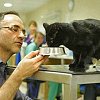 While cats can lead quite a good life with only three legs, it's more difficult with just two (Anakin manages well but in a rather different way). It looked initially as though Oscar might well have to be put to sleep, as he would not have been able to lead a reasonably normal life. However, the vet gave Oscar's owners some hope when he referred the cat to Professor Noel Fitzpatrick, a vet on the mainland in Surrey, not far from London, who is a pioneer in prosthetic surgery. He runs a state-of-the-art practice that could rival many hospitals, with its own MRI room, a hydrotherapy pool and all modern veterinary facilities. In a previous operation he had given Storm, a Belgian shepherd dog, a unique prosthetic paw attached to a titanium rod implanted directly into Storm's foreleg, joining the skin with the metal prosthesis. It proved a great success, to the extent that Storm had to have the prosthesis replaced because he was leading such an active life that he had worn it out!
While cats can lead quite a good life with only three legs, it's more difficult with just two (Anakin manages well but in a rather different way). It looked initially as though Oscar might well have to be put to sleep, as he would not have been able to lead a reasonably normal life. However, the vet gave Oscar's owners some hope when he referred the cat to Professor Noel Fitzpatrick, a vet on the mainland in Surrey, not far from London, who is a pioneer in prosthetic surgery. He runs a state-of-the-art practice that could rival many hospitals, with its own MRI room, a hydrotherapy pool and all modern veterinary facilities. In a previous operation he had given Storm, a Belgian shepherd dog, a unique prosthetic paw attached to a titanium rod implanted directly into Storm's foreleg, joining the skin with the metal prosthesis. It proved a great success, to the extent that Storm had to have the prosthesis replaced because he was leading such an active life that he had worn it out!
To go ahead or not?
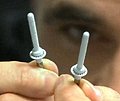
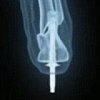 There was much heart-searching to be done as to whether it would be right or fair to subject Oscar to further lengthy operations and recuperation from what would be a ground-breaking procedure — quite apart from the further expense, although Oscar's owners would not have to foot the entire bill — but Professor Fitzpatrick felt there was hope for Oscar, although no animal had previously had two feet replaced. And so the decision was made to go ahead. Oscar was flown to England (at a cost of £600, some 900 US dollars, for a 40-minute flight). Custom-made implants (left) were attached internally to the ankle joints by drilling into the bones above where the feet had been amputated — a procedure that needed great care and precision as a cat's ankle bones are so small. The implants emerge from the skin rather like a pair of stilts (right). They're coated with hydroxyapatite, a material that imitates the way the bones of a deer's antlers mesh with soft tissue, and have a honeycomb structure that allows skin to bond to them, sealing them against infection. The flesh and bone bond to the bionic limbs well enough that they can bear weight and be flexible under the skin.
There was much heart-searching to be done as to whether it would be right or fair to subject Oscar to further lengthy operations and recuperation from what would be a ground-breaking procedure — quite apart from the further expense, although Oscar's owners would not have to foot the entire bill — but Professor Fitzpatrick felt there was hope for Oscar, although no animal had previously had two feet replaced. And so the decision was made to go ahead. Oscar was flown to England (at a cost of £600, some 900 US dollars, for a 40-minute flight). Custom-made implants (left) were attached internally to the ankle joints by drilling into the bones above where the feet had been amputated — a procedure that needed great care and precision as a cat's ankle bones are so small. The implants emerge from the skin rather like a pair of stilts (right). They're coated with hydroxyapatite, a material that imitates the way the bones of a deer's antlers mesh with soft tissue, and have a honeycomb structure that allows skin to bond to them, sealing them against infection. The flesh and bone bond to the bionic limbs well enough that they can bear weight and be flexible under the skin.
The operation to attach the implants lasted three hours; they cost £2000 each (about 3000 US dollars at 2010 rates). Technically they're called ITAPs — intraosseous transcutaneous amputation prosthetics — and were developed at University College, London by biomedical engineer Professor Gordon Blunn and his colleagues.
The new paws
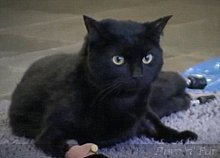 Once Oscar's implants had been successfully inserted and had healed, new feet were attached simply by screwing them into the end of the implants. At first these were prototypes (left) developed at the University of Salford, made of rubber and with a degree of 'wobble'. They were intended to encourage Oscar to use his feet, and allowed him to walk fairly normally and even do a bit of climbing; but they were brown so were modified with black adhesive tape so they did not look too out of place on a black cat! But before long he had four pairs of longer-lasting 'blade runner'-style feet of rubber and metal, which were not only more durable but allowed him to run and climb more easily. They resemble the prosthetics used by Paralympic champion athlete Oscar Pistorius. However, the artificial paws were never going to be suitable for a full outdoor life, so Oscar had to become more of an indoor cat, although he was allowed out on occasion under supervision.
Once Oscar's implants had been successfully inserted and had healed, new feet were attached simply by screwing them into the end of the implants. At first these were prototypes (left) developed at the University of Salford, made of rubber and with a degree of 'wobble'. They were intended to encourage Oscar to use his feet, and allowed him to walk fairly normally and even do a bit of climbing; but they were brown so were modified with black adhesive tape so they did not look too out of place on a black cat! But before long he had four pairs of longer-lasting 'blade runner'-style feet of rubber and metal, which were not only more durable but allowed him to run and climb more easily. They resemble the prosthetics used by Paralympic champion athlete Oscar Pistorius. However, the artificial paws were never going to be suitable for a full outdoor life, so Oscar had to become more of an indoor cat, although he was allowed out on occasion under supervision.
Wide media attention
 Oscar's story was released to the world in late June 2010. Since the accident he had spent eight months at Fitzpatrick's practice. There's a good account, from which we have used information and a couple of images, at the Daily Mail. Oscar and his ground-breaking new paws were featured in a British TV series called The Bionic Vet in early July. In August 2010 Fitzpatrick's practice posted a video update of Oscar's progress: it shows him three weeks after his more advanced and improved 'blades' had been fitted and explains the thinking behind them.
Oscar's story was released to the world in late June 2010. Since the accident he had spent eight months at Fitzpatrick's practice. There's a good account, from which we have used information and a couple of images, at the Daily Mail. Oscar and his ground-breaking new paws were featured in a British TV series called The Bionic Vet in early July. In August 2010 Fitzpatrick's practice posted a video update of Oscar's progress: it shows him three weeks after his more advanced and improved 'blades' had been fitted and explains the thinking behind them.
New home in England
 Since Oscar would need periodic check-ups after his operation, it was felt best, after lengthy discussion, that he remain in England rather than subjecting him to the stress of journeys back and forth between England and Jersey. A home was found for him in a country house quite near the practice, with Fitzpatrick Referrals' project manager Matt Connor, and Oscar settled in happily there. Mike and Kate were able to visit him in July 2011. Then events took an unexpected turn when the landlord of Matt's house decided he was no longer going to allow pets. At that point, therefore, although it had been almost two years since his accident, Oscar finally went home to Jersey, we think sometime before September 2011. Mike went to collect him and bring him back in the car via the ferry. Three short clips of Oscar at home were uploaded to YouTube in January 2012 by his owners, all available from their channel page TheBionicCat: he looks very content, doing all the usual things that cats do! Apart from a further trip to the vet to have a broken tooth removed, he was in good health and leading a fairly normal life.
Since Oscar would need periodic check-ups after his operation, it was felt best, after lengthy discussion, that he remain in England rather than subjecting him to the stress of journeys back and forth between England and Jersey. A home was found for him in a country house quite near the practice, with Fitzpatrick Referrals' project manager Matt Connor, and Oscar settled in happily there. Mike and Kate were able to visit him in July 2011. Then events took an unexpected turn when the landlord of Matt's house decided he was no longer going to allow pets. At that point, therefore, although it had been almost two years since his accident, Oscar finally went home to Jersey, we think sometime before September 2011. Mike went to collect him and bring him back in the car via the ferry. Three short clips of Oscar at home were uploaded to YouTube in January 2012 by his owners, all available from their channel page TheBionicCat: he looks very content, doing all the usual things that cats do! Apart from a further trip to the vet to have a broken tooth removed, he was in good health and leading a fairly normal life.
Fitzpatrick's ethos
The whole procedure with Oscar cost in the region of £30,000, or about 50,000 US dollars at 2010 rates, much of the funding coming from Fitzpatrick's practice. He regarded it as pioneering work that had exciting implications for the treatment of severely disabled humans, too, and not only animals. And Professor Fitzpatrick was adamant that he wasn't simply experimenting, or performing such operations 'because he can'. He said, 'I know where to draw the line. Animals are sentient creatures, with needs and wants. Doing a procedure just because it can be done is not ethical. I'll do it only if the perceived outcome improves the animal's quality of life.'
Disaster
Then, when all seemed finally to be going well, there was a further major setback: in August 2012 one of Oscar's implants broke. The titanium rod snapped at the exit point from the stump of the leg, leaving him seriously off balance: he couldn't walk properly. For an active cat in the prime of life — he was just five years old — it was a major blow. Once again he was treated by his Jersey vet and made comfortable, while urgent contact was made with Noel Fitzpatrick for advice. He said he would be able to carry out a further operation, but it would mean inserting a longer implant, further up the leg, and of course it would again mean a lengthy convalescence. There was also the matter of expense, several more thousands of pounds: but they would find the money somehow if required. A further complication was that the company that had made the implants was no longer in business.
What should be done?
 There followed many long, agonising discussions as to the best course of action, always with Oscar's best interests at heart. Would it be in any way fair to subject him to more major surgery, after all he'd already been through? Or would it be kinder to just have him gently put to sleep? He was a wonderful cat and they didn't think they would ever have another like him, but that in itself wasn't a reason for keeping him if it meant more suffering for him. In Kate's early-2013 book about Oscar (see our Folios section) she left the matter unresolved at the end, with no decision having been made — but a search revealed further information.
There followed many long, agonising discussions as to the best course of action, always with Oscar's best interests at heart. Would it be in any way fair to subject him to more major surgery, after all he'd already been through? Or would it be kinder to just have him gently put to sleep? He was a wonderful cat and they didn't think they would ever have another like him, but that in itself wasn't a reason for keeping him if it meant more suffering for him. In Kate's early-2013 book about Oscar (see our Folios section) she left the matter unresolved at the end, with no decision having been made — but a search revealed further information.
Later news
There were few details, but it seemed it was decided to 'keep going', and for a while Oscar was learning to cope with just three legs. In mid-April 2013 Kate said he 'was hopping around just as much as before and can still jump on the bed and the chairs'. Later in the year, though, he apparently underwent a further operation and was back to four feet. It wasn't clear if he'd returned to Noel Fitzpatrick or there'd been some other option, but by mid-October he'd had the operation and was recovering well, with the hope that he would be home soon. By early November 2013 he was 'learning to walk on four feet again, and doing really well' and it appeared that by Christmas he was back at home in Jersey.

 May 2014 saw the airing on Channel 4 of a further TV documentary series covering the work of Noel and his team, The Supervet, and in the first episode it became clear what had transpired with Oscar in 2013. He had indeed ultimately returned to the Fitzpatrick practice for a further procedure to address the snapped prosthesis. It was also found that infection had returned to the ankle. It was amputated then a new implant was inserted higher up his leg into the shinbone, but with no movable ankle, as there still was with his other hind leg, it had been necessary to design a new and different type of foot to screw onto the implant. The next-generation prosthesis was called a PerFits. The surgery was a success and, as before, once his new foot was attached Oscar was up and about!
May 2014 saw the airing on Channel 4 of a further TV documentary series covering the work of Noel and his team, The Supervet, and in the first episode it became clear what had transpired with Oscar in 2013. He had indeed ultimately returned to the Fitzpatrick practice for a further procedure to address the snapped prosthesis. It was also found that infection had returned to the ankle. It was amputated then a new implant was inserted higher up his leg into the shinbone, but with no movable ankle, as there still was with his other hind leg, it had been necessary to design a new and different type of foot to screw onto the implant. The next-generation prosthesis was called a PerFits. The surgery was a success and, as before, once his new foot was attached Oscar was up and about!
So Oscar rebounded once again; let's hope there are no more mishaps for this brave little cat!
Update
In 2018 his human Mike Nolan reported that Oscar was 11 in July of that year and was still going strong. See his comment beneath this tweet by Fitzpatrick Referrals. And in November 2019 the New Era Veterinary Hospital in Jersey (where Oscar was first treated) responded to a Facebook message from Mike Nolan which celebrated some 10 years since the incident with the combine harvester, reported that Oscar was alive and well and included a photo.
Further links
- BBC Jersey, Jun 2010: A cat from Jersey has shot to fame as the 'bionic cat'.
- Guardian, Jun 2010: Paws for thought: pioneering surgery puts cat back on his feet.
- The original of an excellent BBC clip explaining the procedure and the fitting of Oscar's (first) new feet is no longer included at the BBC page, but it has been uploaded to YouTube: A bionic cat.
- CBS News, Jun 2010: Oscar the 'bionic' cat - shows Oscar's blades, and Noel explains the procedure.
- Smithsonian Channel: The Bionic Vet: Oscar's New Feet - includes footage from the operation.
- Animal Planet's Weird, True & Freaky strand, Oct 2010: a short clip on Oscar's story.
- Daily Telegraph, Nov 2010: The Bionic Vet: he can rebuild them.
- ChannelOnline TV/Jersey News, Sep 2011: following his return home, a news clip of Oscar and interview with his owners.
- Kate Allan writing in the Daily Mail, Feb 2013: The £50,000 bionic cat.
- Fitzpatrick Referrals, 2014: Oscar.
- Channel 4 at YouTube, May 2014: The Bionic Cat.
- Facebook: Oscar The Bionic Cat (NB: the page is maintained by a fan, not by Oscar's owners).
- Essential Surrey, Feb 2014: The Supervet: We interview Noel Fitzpatrick.
- 2011: Fitzpatrick Referrals' own promotional video, in the form of a guided tour of the practice and its world-class facilities, includes a scene with Oscar walking on his blades.
- 2011: an interesting and enlightening clip from the University of Surrey in which Fitzpatrick talks about his training in and passion for veterinary bioscience, and how current research and his work in this area has exciting and far-reaching implications for both animals and humans. While Oscar's case isn't mentioned specifically, it illustrates these hopes and aims very well.
